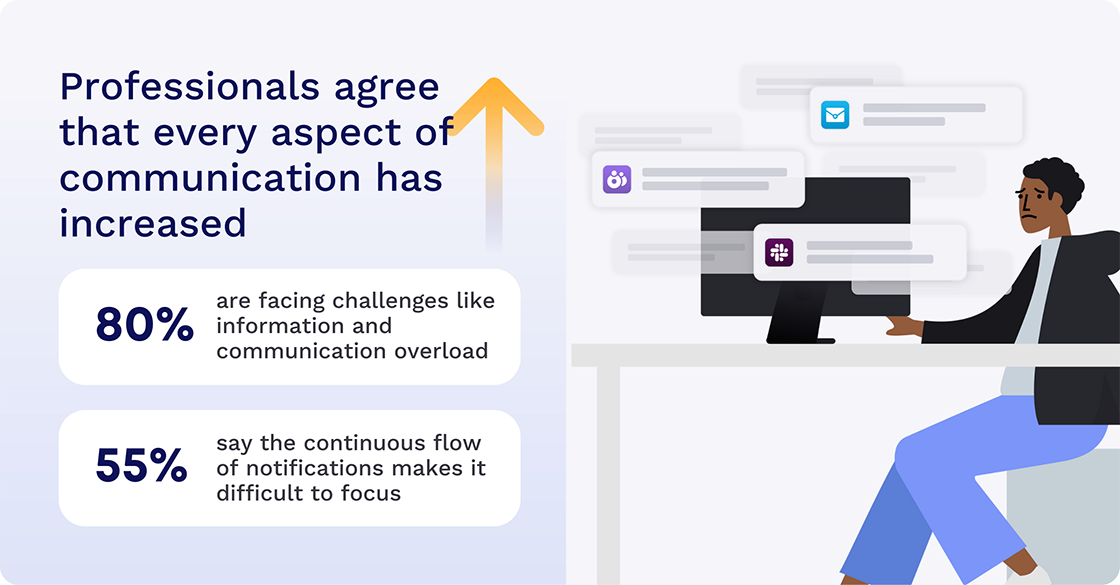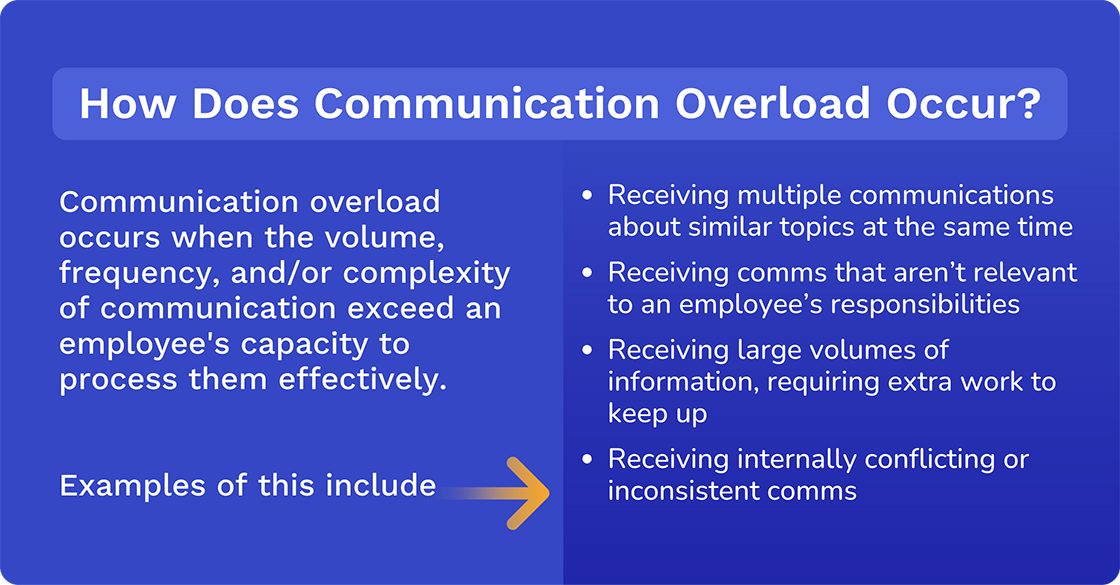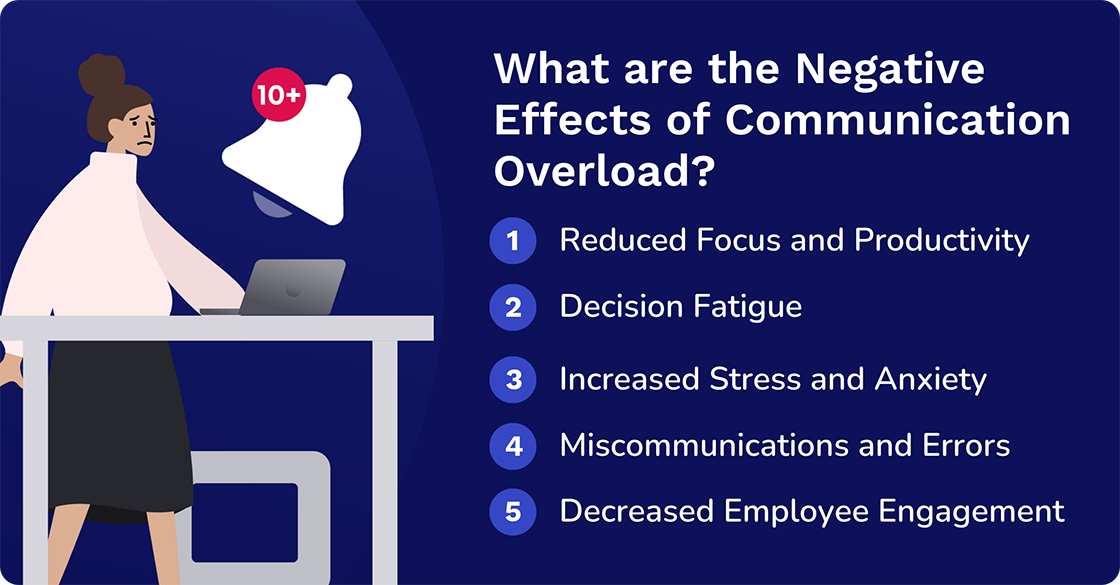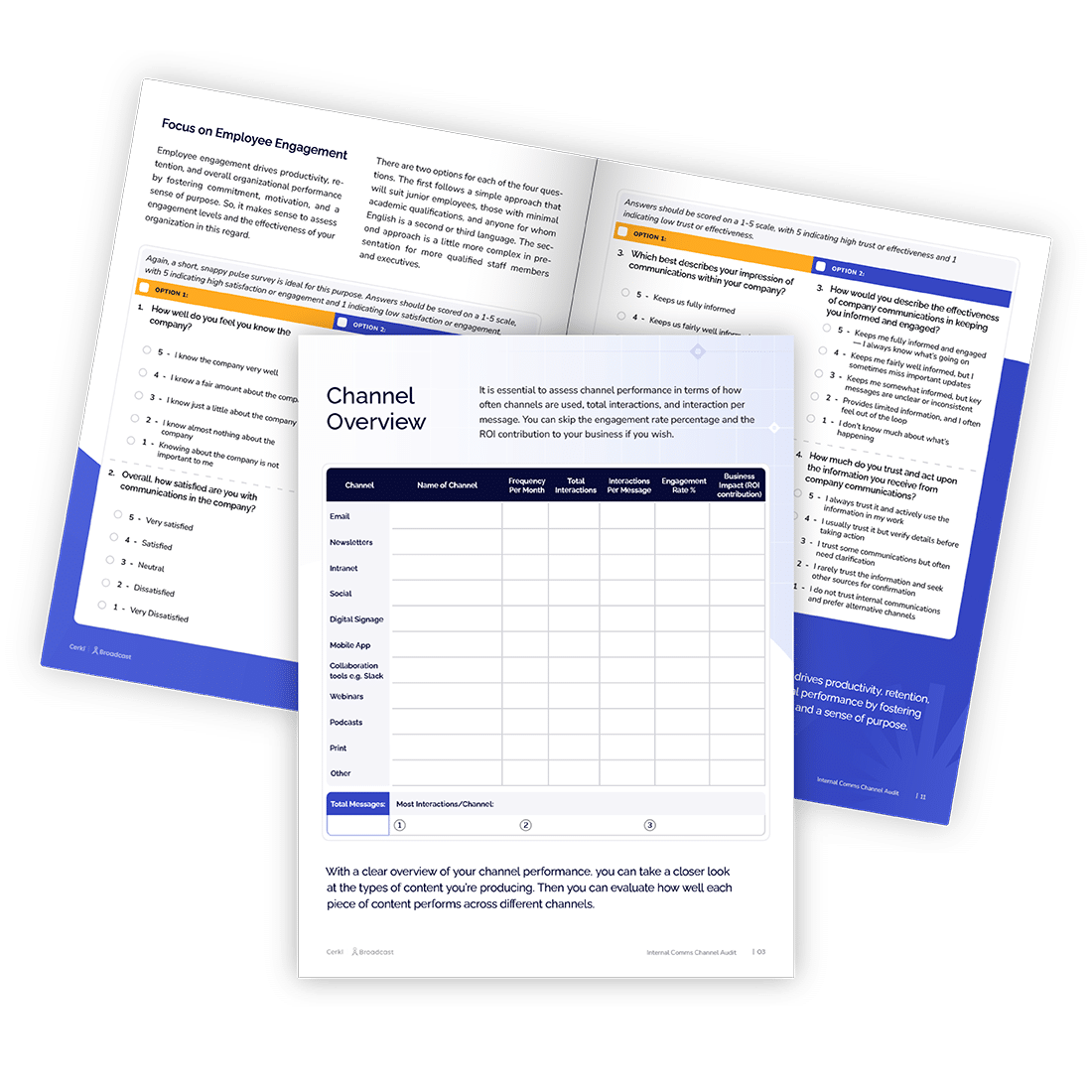Communication is vital in the work environment. But the negative impacts of communication overload can outweigh the advantages. These strategies are your solution.

.png)
Strategy is an important component of internal communications. Ensure you’re communicating through the right channels at the right frequency with our Internal Communications Channel Audit worksheet.
Access NowCommunication overload and multitasking can have a significant impact on mental well-being and productivity. When faced with an overwhelming amount of data, employees may experience increased anxiety and cognitive impairment. This can lead to forgotten tasks, missed deadlines, and missed meetings. To mitigate these effects and manage communication overload, it's essential to prioritize focus and to streamline communication. It is also vital to establish effective task management strategies to reduce the risk of mental fatigue and maintain peak performance.
The Harris Poll and Grammarly 2024 State of Business Communication report highlights the ongoing — and ever increasing — importance of effective communication. As we know, it is a vital element in the business world today, leading to immensely positive business outcomes, However, miscommunication impedes productivity, negatively impacting morale and potentially affecting a company’s bottom line.
Professionals agree that every aspect of communication has increased, with 80% of professionals facing communication challenges like information and communication overload.
If you identify with these respondents, you might feel frustrated or even threatened by communication overload. Happily, there are powerful strategies that you can use to reduce communication overload.
We have identified eight proven strategies that internal communicators can use to mitigate communication overload. By implementing these tactics, you can help your colleagues navigate the information deluge, reclaim their focus, and foster a communication culture that thrives.

Internal communicators understand the importance of information flow. Get it right, and you’ll increase employee engagement and productivity, and improve the overall employee experience. Get it wrong, and you’ll be in danger of imposing communication overload.
Quite simply, communication overload occurs when the volume, frequency, and/or complexity of communication exceed an employee's capacity to process them effectively. It results in a state of information saturation where that person receives an excessive amount of messages, notifications, emails, or other forms of communication. They just don’t have the capacity to process and respond to them effectively. This can lead to feelings of anxiety and stress, making it difficult for employees to prioritize tasks, make decisions, and maintain focus.
Upgrade your company’s internal comms to enhance employee communication

An article in Harvard Business Review, Reducing Information Overload in Your Organization, emphasizes that communication overload is not only about information volumes. “Rather, the real culprit is the information itself — and specifically the degree to which the accessing and interpreting of the information imposes extra “work” on its recipient.”
They define information burden — which is essentially communication overload — as being duplicative, irrelevant, effort intensive, and/or inconsistent.
It's essential to develop strategies to manage communication effectively, prioritize tasks, and maintain a healthy work-life balance to mitigate the negative effects of communication overload.

The Grammarly report points out that communication dominates the time we spend at work. Because professionals are spending more time communicating about work-related issues, knowledge workers now spend 88% of their work week communicating.
“For some functions, the average time spent communicating now exceeds the conventional work week, with knowledge workers in fields like HR (47 hours per week), with hybrid work setups (42 hours), or on large teams (42 hours) communicating with others the most each week.” Grammarly
Gartner also identifies “an ever-growing burden of information.”
“These feelings of information overload can have real, negative business impacts, including less alignment with corporate strategy and a lower intent to stay in the organization. Moreover, in a hybrid world, the digital tools employees use to do their work have an outsized impact on their overall employee experience.”
Gartner
This introduces questions about the impact of digital communication and the digital employee experience. An analysis by Forbes Advisor, found that digital communication makes 58% of workers feel like they need to be available more often. Also, 60% of employees are likely to experience increased burnout as a result of digital communication.
The negative effects of communication overload are well documented:

There are a wealth of strategies and internal communication best practices that will minimize or even eliminate communication overload in the workplace. Here are eight of them.
The Harris Poll/Grammarly 2024 State of Business Communication report is sub-titled AI’s potential to turn overload into impact. It predicts that generative artificial intelligence (gen AI) will transform workplace communication. It also confidently estimates that using gen AI for communication could save the U.S. as much as $1.6 trillion in productivity annually. But its potential is largely untapped, primarily because employees don’t have the necessary gen AI skills.
The report states that to fully leverage the benefits of AI investment, organizations need to harness the AI experimentation that is already happening across individuals and teams. For example, 60% of professionals already use AI for work, and 61% of knowledge workers are on teams that plan to implement gen AI for communication tasks.
The Loom Mind the Communication Gap report is all about how communication overload is derailing workplace productivity. They state that strong communication skills are a prerequisite for an effective workplace. “But being a good communicator today looks different in practice than it did even 10 years ago.”
One of the biggest differences is due to AI. While 50% of American workers “would feel comfortable using AI to improve or supplement their workplace communication,” 56% are wary about introducing AI into workplace communication.
So, how can you leverage automation and AI?
Upgrade your company’s internal comms to enhance employee communication

By implementing these additional strategies, internal communicators can become powerful allies in the fight against communication overload. Remember, collaboration is key. By working together with employees and leadership, you can create a more focused and productive work environment for everyone.

Organizations are responsible for selecting and implementing internal communication software to combat communication overload. The challenge is to find a platform that enables them to consolidate channels, target messaging, prioritize information, and promote clear communication practices.
Cerkl Broadcast is an omnichannel communication platform that can help reduce communication overload in many different ways.

A communication audit will enable you to analyze the effectiveness of your current internal comms strategy. As mentioned earlier, we are offering you a free template with no risk or commitment. Once you’ve completed the template, we will be able to provide you with free, personalized advice on how to improve your internal communications approach. It’s your call. We’d love to help reduce communication overload in your organization.

Upgrade your company’s internal comms to enhance employee communication
What happens when people experience communication overload? When people experience communication overload, they tend to become overwhelmed by the constant influx of messages and information. This can lead to decreased productivity, increased stress, and difficulty focusing on important tasks.
What is an example of communication overload? A good example of communication overload is when an employee receives multiple emails, instant messages, and texts from their manager, colleagues, and HR department, all asking for updates, feedback, or information, causing them to feel bombarded and overwhelmed.
How to fix communication overload? To fix and manage communication overload, organizations can implement strategies such as prioritizing clear and concise messaging, setting realistic communication expectations, and providing training on effective communication skills. They can also leverage technology to streamline and automate communication processes. By introducing a strategy to reduce communication overload, organizations can reduce information overload, improve employee engagement, and increase productivity.

Upgrade your company’s internal comms to enhance employee communication